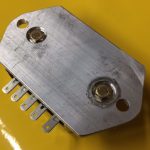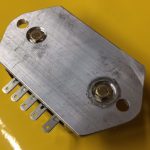So, how the hell was I supposed to know that the rather mundane looking car getting its rolling glamour shot in the street in front of our hotel was a super secret new model? I was as shocked as anybody, especially when the video producer and the lady from the ad agency tracked us down in the street in Copenhagen and explained that they were about to lose their jobs because of a tweet I posted… and the numerous bloggers who had copied my video to YouTube and were blogging about he “secret spy photos” of the new Citröen.
I have a French lawyer now…
It started out innocently enough. Lisa and I were on vacation in Copenhagen, and after a fantastic week this was our last night in the hotel (actually a studio apartment) where we were staying. I had stepped out to get a few things at the little grocery store around the corner. When I tried to return to the apartment, there were some people in high-visibility yellow vests keeping everyone back from the street. After a few minutes I figured out that they were there to shoot footage of a car for a commercial. The car didn’t look like anything exotic — a little Citröen wagon style like we’d seen dozens of times around Copenhagen, although this one lacked the bumpy plastic panels in the doors. Eventually there was a pause in the preparation and they let a few of us who had been patiently waiting cross the street. I saw the camera truck, a well used vehicle with an articulating arm from which hung the video camera on a stabilizing mount. The car wasn’t terribly interesting but the camera rig was pretty cool, actually; my geek side liked it.
A little later on, up in the third floor apartment, I watched from the balcony as they made a couple more passes down the street. The camera truck and the movie star Citröen would drive down the street in tight formation, then they’d come back and do it again. Before I came back inside I shot some video with my iPhone of the process. Seeing the camera swivel on the end of its arm was pretty slick, and now I knew how some of the moving vehicle shots we see all the time in commercials and movies are done.
Knowing that my son would enjoy seeing the process as well, I tweeted the video and tagged him. Unfortunately, I mentioned Citröen as well. That was a big mistake, as it turns out. If I hadn’t done that, this probably wouldn’t be a story. Probably only two people in the world would have seen that video, and neither live in a country where many people pay much attention to Citröen, who hasn’t sold a new vehicle in the US since Ford was President.
The next morning we checked out and headed to the train station, dragging our wheeled luggage along. We’d been walking the entire week in Denmark, averaging between 5 and 6 miles a day, and the train station was a little under a kilometer away. We were about halfway there when a car pulled up to the curb along side. In it were a woman and a man, both looking a little concerned. They asked if I was Dale, I said yes, and they both got out. They had been shooting a car commercial the day before, they said, and now they had a big problem. I was a little puzzled… if I’d accidentally gotten into a shot, they could just work around it. No, it was “the video I had posted to YouTube and the blogs”. What?? I didn’t post anything to YouTube. Well, Citröen was livid, her boss was about to fire her, and there was a huge problem because, unbeknownst to me, that was the new and as-yet-unannounced refresh of that model. No one was supposed to see it, and now people had.
They had gone back to the shoot location, figured out the balcony from which the video had been shot, and asked the desk clerk who was staying there. The hotel staff told them we’d just checked out and were headed to the airport, and they drove around until they found us. If it had taken them ten minutes longer, we’d have been long gone and out of touch for the next 18 – 20 hours or so.
I showed them the tweet, and the woman (who was French — the man was Danish) asked if I would delete it. Sure, absolutely, I don’t want to cause them any trouble. Tweet deleted. Unfortunately, some jackass had copied the video and posted it to YouTube — with my name included in the video title. Great. And a bunch of bloggers were now claiming to have “exclusive spy photos”, which were actually still frames taken from my video. No one had asked me to use or copy it, of course. No one other than the first guy had even bothered attributing the video to me at all. Honestly I was feeling mixed emotions — a little embarrassed for having caused these poor people so much trouble, and a little pissed off that these other jackasses were using my footage, AND claiming credit for it to try to make themselves look like more than the simple scavengers they are.
We had to get to the airport, but I promised to work with the woman to get the copies removed wherever we could. I knew we were going to be playing Whack-A-Mole… once that kind of stuff is in the wild, your chances of suppressing it are slim. I sent an email to the guy who had posted the video to YouTube, and sent YouTube a takedown notice. It’s all we could do before we had to get on the plane home.
Over the next few days, I spend a couple hours a day following up on various places where the video and stills from it were posted. Twitter accounts popped up like zits on a high schooler. Some jackasses were making new YouTube videos with slideshows of still images captured from the video. There were blogs in France, the Netherlands and India, all using the same three or four stills — meaning they were late to the party and just copying images from other people’s Twitter posts, which were using images swiped from the YT video, which was swiped from my tweet.
The French woman’s daughter is an attorney, and I gave her permission to defend my rights to the video and still images in the EU, pursuing whatever action she needed to in the courts over there. Not because I’m worried about the video — I’m not making one single penny from it or the pictures I got. I don’t want to cause Citröen any problems; they’ve never done anything to me. I had no idea that the commercial shoot involved a model that no one had seen (more about that later), and I don’t want my video to cause the ad agency or production company to incur the wrath of their customer. I’m just trying to minimize the damage. And to be honest, it pisses me off that these other jackasses are basically stealing my work, claiming it as their own, and profiting from it through ad revenues. Not a single one of them has once asked permission to use the footage, given any credit or attribution, offered one cent of compensation, responded to a request to remove it, or cooperated in any way. In fact they are mostly claiming credit for the “spy photos” of the new model — taken in New York. Screw them.
Citröen’s outrage, however, has been slightly disingenuous. While searching for more copies of my stuff, I came across many other photos of the same model — the exact same, in fact. Different color. Apparently Citröen had accidentally enabled the new 2018 model configurator on its web site at some point – allowing people to see exactly, in high resolution detail, what the 2018 model looks like. They pulled it, of course, but again — once that stuff is out there, it’s not going to disappear.







